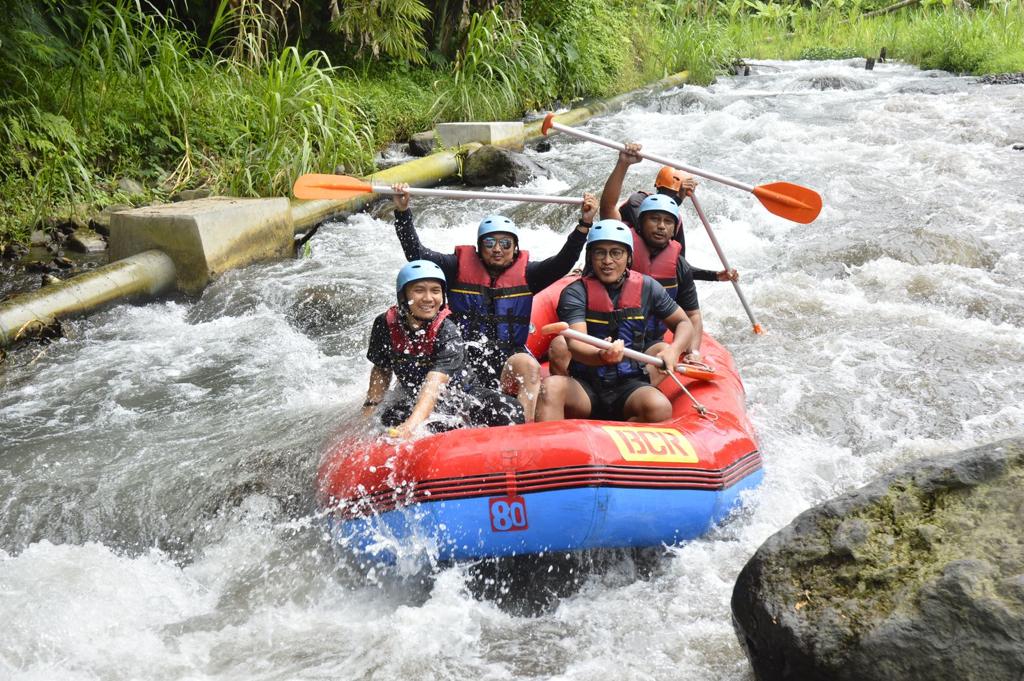Know The Unique Facts Of Telaga Waja River Before Rafting!
Telaga Waja River is one of the best destinations for rafting activities in Bali. Located in Karangasem Regency, this river is known for its challenging rapids and beautiful natural scenery. With a length of about 16 kilometers, Telaga Waja offers a longer rafting experience than other rivers in Bali, providing an unforgettable sensation of adventure.
The flow of water from Mount Agung’s mountain springs keeps the river clear throughout the year, making it an ideal spot for nature and water sports lovers. In addition to the challenge of the river’s current, tourists can also enjoy the beauty of the surrounding nature filled with shady trees, towering cliffs, and small waterfalls hidden at several points along the way.
Before trying rafting in Telaga Waja, there are some interesting facts that must be known to make the experience more memorable and maximized.
Read More: Rafting in Telaga Waja Is The Most Exciting Adventure!
The Origin and Uniqueness of Telaga Waja River
Telaga Waja River has a history that is closely related to the local community. The name “Telaga Waja” is believed to come from the word “telaga” which means lake or water source, and “waja” which means steel or strong. The river is considered as one of the sources of life for the locals and is often associated with the myth of the sanctity of its water coming from Mount Agung, the highest and most sacred mountain in Bali.
In addition, Telaga Waja is famous for its long flow characteristics, reaching about 16 kilometers, making it one of the longest rivers for rafting in Bali. The river has quite a challenging route, with adrenaline-pumping rapids, but it is still safe for beginners as the current tends to be stable compared to other rivers.
Mountain Springs from Mount Agung
One of the main attractions of Telaga Waja River is the clarity of its water. The river gets its water supply directly from the mountain springs of Mount Agung, so the water is very clean and fresh. Compared to other rivers that may be polluted by human activities, Telaga Waja remains natural because it is far from the city center and industrial areas.
The specialty of its water is also often utilized by locals for their daily needs. Some tourists even drink water from this river directly while rafting because of its excellent quality.
Biodiversity Along the Telaga Waja River
Along the way down the Telaga Waja River, tourists will be presented with extraordinary natural scenery. Lush tropical forests, sprawling green rice fields, and high cliffs that add a dramatic impression to the rafting adventure.
Not only that, the river is also home to a variety of unique flora and fauna, such as:
- Exotic birds, such as kingfishers and eagles, which can often be seen flying low around the river.
- Colorful butterflies, especially during the dry season, when the vegetation along the river is in bloom.
- Long-tailed macaques, which can sometimes be seen playing in the trees around the river.
- Freshwater fish, which live in some of the calmer parts of the river.
This natural beauty makes rafting in Telaga Waja not only about extreme sports, but also a memorable nature experience.

How Do Seasonal Changes Affect Rafting?
Like most rivers in the tropics, the water discharge of Telaga Waja River is affected by seasonal changes. There are significant differences in the rafting experience depending on the season when visiting:
Dry Season (April – October):
- The water discharge is more stable and less swift, making it safer for beginners.
- The scenery is brighter with beautiful blue skies.
- The trip is more comfortable as the current is easier to control.
Rainy Season (November – March):
- Water discharge increases and the current becomes stronger, providing a more challenging rafting sensation.
- The trip can be faster due to the swift river flow.
- More caution is required as some trails can be more difficult to navigate.
Whether it is the dry season or the rainy season, Telaga Waja River still offers an exciting rafting experience. However, for beginners, it is recommended to come during the dry season to make it easier to enjoy the trip.
Hidden Spots in Telaga Waja River
In addition to challenging rapids, Telaga Waja River also has several hidden spots that add to its appeal. Some interesting places that can be found during the rafting trip include:
- Mini Waterfalls – At some points, tourists will pass by small waterfalls that flow directly into the river. Some rafting participants even choose to stop for a moment to enjoy the freshness of the water.
- Natural Caves – Along the river cliffs, there are small caves formed naturally due to the erosion process. Some of these caves serve as sanctuaries for birds and bats.
- Terraced Rice Fields – The rafting route also passes through a stretch of Balinese terraced rice fields, providing a unique experience of seeing the lives of local farmers in the midst of rafting activities.
- Traditional Bamboo Bridge – One of the highlights of Telaga Waja River is the bamboo bridge used by locals to cross the river.
Conclusion
Telaga Waja River is not just a location for rafting, but also has various uniqueness that makes it one of the best rivers to visit in Bali. With clear water from Mount Agung, rich flora and fauna, and a variety of interesting hidden spots, rafting on this river offers an experience that is more than just water sports.
For travelers looking for a combination of adventure and natural beauty, Telaga Waja is the perfect choice. Before attempting rafting here, knowing these unique facts will add to the excitement of the trip. So, are you ready to conquer the rapids of Telaga Waja River?

